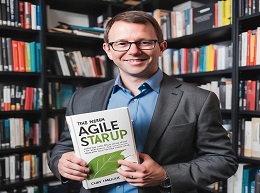The Lean Startup

In today's fast-paced business landscape, startups face numerous challenges, from limited resources to fierce competition. However, amidst these challenges lies an innovative approach that has revolutionized entrepreneurship the Lean Startup methodology. Developed by Eric Ries, The Lean Startup offers a systematic framework for building and scaling successful startups by prioritizing experimentation, rapid iteration, and validated learning. In this comprehensive review, we'll delve into the core principles of The Lean Startup, explore real-world examples of its application, and uncover how entrepreneurs can leverage this approach to achieve sustainable growth and success.
Understanding The Lean Startup Philosophy:
At the heart of The Lean Startup philosophy lies a fundamental shift in how entrepreneurs approach building and scaling their ventures. Rather than relying on traditional business planning and long development cycles, The Lean Startup advocates for a scientific approach to entrepreneurship. This approach centers around the concept of validated learning, wherein startups test hypotheses through rapid experimentation, gather feedback from customers, and iterate based on empirical data. By embracing uncertainty and prioritizing learning over planning, entrepreneurs can adapt to market changes more effectively and increase their chances of success.
Example:
Consider the story of Dropbox, a cloud storage service that disrupted the industry with its simple yet powerful solution. Instead of spending years developing a fully-featured product, Dropbox's founders released a Minimum Viable Product (MVP) a simple file-sharing tool to gauge interest and gather feedback. By iterating based on user feedback and continuously improving their product, Dropbox grew into a multi-billion-dollar company, demonstrating the effectiveness of The Lean Startup approach.
The Importance of Minimum Viable Products (MVPs):
A cornerstone of The Lean Startup methodology is the concept of Minimum Viable Products (MVPs). MVPs are stripped-down versions of a product that allow startups to test their hypotheses with minimal resources. By focusing on delivering core features and functionalities, startups can validate their ideas, gather feedback from early adopters, and iterate based on real-world data. MVPs enable startups to minimize waste, reduce time to market, and mitigate risks associated with building elaborate products that may not meet customer needs.
Example:
Consider the case of Airbnb, the now-iconic platform that revolutionized the travel and hospitality industry. In its early days, Airbnb faced skepticism from investors and struggled to gain traction. However, by launching a simple MVP—a website that allowed users to rent out air mattresses in their living rooms—the founders were able to validate their idea and identify key pain points and opportunities for improvement. Over time, Airbnb iterated on its MVP, adding features based on user feedback and expanding its offerings to include a wide range of accommodations worldwide.
The Build-Measure-Learn Feedback Loop:
Central to The Lean Startup methodology is the Build-Measure-Learn feedback loop a continuous cycle of experimentation and iteration. Startups begin by formulating hypotheses about their target market, product features, or business model. They then build an MVP to test these hypotheses, measure its performance using actionable metrics, and learn from the feedback to inform their next steps. This iterative process allows startups to make data-driven decisions, adapt to changing market conditions, and optimize their product or service for maximum impact.
Example:
Take the example of Instagram, the photo-sharing app that quickly became a cultural phenomenon. In its early days, Instagram's founders launched a simple MVP a photo-sharing app with filters and social features to test their hypothesis that users craved a more visual and interactive way to connect with friends. As the app gained traction, the founders closely monitored user engagement and feedback, iterating on features and functionality based on real-time data. This relentless focus on the Build-Measure-Learn loop enabled Instagram to rapidly evolve and grow its user base, eventually attracting the attention of Facebook, which acquired the company for $1 billion.
Embracing Pivots and Perseverance:
Despite careful planning and diligent execution, startups often encounter roadblocks and unexpected challenges along their journey. The Lean Startup methodology acknowledges the inevitability of failure and encourages entrepreneurs to embrace pivots—the act of fundamentally changing direction based on new insights or market feedback. While pivots require courage and flexibility, they can also lead to breakthroughs and new opportunities for growth. However, it's equally important for entrepreneurs to know when to persevere—to stay true to their vision and double down on their efforts, even in the face of adversity.
Example:
Consider the story of Slack, the wildly successful team communication platform. Originally launched as a gaming company called Tiny Speck, Slack's founders faced challenges with their initial product and struggled to gain traction in the crowded gaming market. However, they recognized an opportunity to pivot and repurpose their internal communication tool into a standalone product for teams. This pivot proved to be a game-changer, as Slack quickly gained popularity among businesses worldwide and grew into a billion-dollar company.
Cultivating a Culture of Innovation:
Beyond its practical techniques and frameworks, The Lean Startup methodology advocates for a culture of innovation one where experimentation, creativity, and learning are celebrated. By fostering an environment where failure is viewed as a learning opportunity rather than a setback, startups can encourage risk-taking, spark creativity, and drive continuous improvement. A culture of innovation empowers employees to challenge the status quo, think outside the box, and contribute their unique perspectives to the company's growth and success.
Example:
Take the example of Google, the tech giant known for its innovative products and services. Google's "20% time" policy a practice that allows employees to spend 20% of their work hours on passion projects encourages creativity and experimentation within the company. This policy has led to the development of some of Google's most successful products, including Gmail and Google Maps, demonstrating the power of a culture that values innovation and empowers employees to pursue their ideas.
In conclusion, The Lean Startup methodology has transformed the way entrepreneurs approach building and scaling their ventures. By prioritizing experimentation, rapid iteration, and validated learning, startups can navigate the uncertainties of entrepreneurship with confidence and agility. From MVPs to pivots, The Lean Startup offers a systematic framework for success one that empowers entrepreneurs to turn their vision into reality and create lasting impact in the world of business. As we continue to witness the rise of startups and innovative ventures, The Lean Startup remains a guiding light for those seeking to disrupt industries, drive change, and build a better future.













